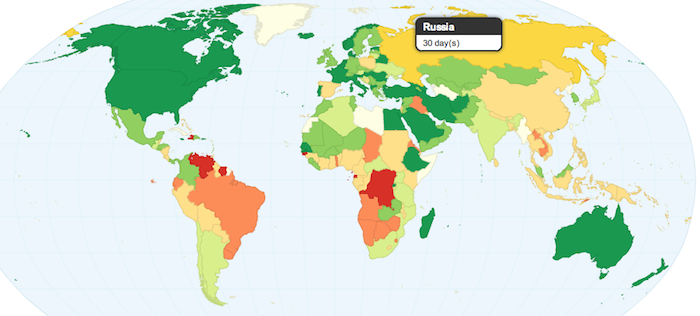 Colleges and universities across the U.S. are recognizing the need for academic offerings that cater to aspiring social entrepreneurs. Paul Tracey and Nelson Phillips point out that there are an "increasing number of social entrepreneurs entering business schools in order to learn the skills and competencies required to build sustainable business, as well as a growing proportion of mainstream businesses incorporating a social dimension in their activities." Programs like the Center for the Advancement of Social Entrepreneurs in the Fuqua School of Business at Duke University and the Program on Social Enterprise at Yale University's School of Management offer programs tailored specifically to social entrepreneurs.
Colleges and universities across the U.S. are recognizing the need for academic offerings that cater to aspiring social entrepreneurs. Paul Tracey and Nelson Phillips point out that there are an "increasing number of social entrepreneurs entering business schools in order to learn the skills and competencies required to build sustainable business, as well as a growing proportion of mainstream businesses incorporating a social dimension in their activities." Programs like the Center for the Advancement of Social Entrepreneurs in the Fuqua School of Business at Duke University and the Program on Social Enterprise at Yale University's School of Management offer programs tailored specifically to social entrepreneurs.
Nevertheless, many institutions for higher education have been slow to adapt to the variety of challenges that arise from the distinct nature of social enterprise. "Entrepreneurship instructors currently face a variety of challenges linked to the diversification of the entrepreneurship student demographic," observe Matthew M. Mars and Sharon Garrison of the University of Arizona. New pedagogical approaches must be developed to teach students who seek to use business skills to tackle social problems.
innovation DAILY
Here we highlight selected innovation related articles from around the world on a daily basis. These articles related to innovation and funding for innovative companies, and best practices for innovation based economic development.
Infographic: How Quickly Can You Start a Business, Around the World?
In the U.S., we take it for granted that starting a business should be quick and simple. But abroad, it can be mind-numbingly complex--and that's one reason why economists often use the number of days it takes to start a business to gauge a country's entrepreneurial competitiveness, its prevalence of red tape, and its straight-up corruption. (Since corruption often starts when there's more red tape--and more opportunities for bribes.)

Scientists identify DNA that may contribute to each person’s uniqueness
 Building on a tool that they developed in yeast four years ago, researchers at the Johns Hopkins University School of Medicine scanned the human genome and discovered what they believe is the reason people have such a variety of physical traits and disease risks.
Building on a tool that they developed in yeast four years ago, researchers at the Johns Hopkins University School of Medicine scanned the human genome and discovered what they believe is the reason people have such a variety of physical traits and disease risks.
In a report published in the June 25 issue of Cell, the team identified a near complete catalog of the DNA segments that copy themselves, move around in, and insert themselves here and there in our genome. The insertion locations of these moveable segments — transposons — in each individual’s genome helps determine why some are short or tall, blond or brunette, and more likely or less likely to have cancer or heart disease. The Johns Hopkins researchers say that tracking the locations of transposons in people with specific diseases might lead to the discovery of new disease genes or mutations.
Light and moderate physical activity reduces the risk of early death
 Even light or moderate intensity physical activity, such as walking or cycling, can substantially reduce the risk of early death, a new study by researchers from the London School of Hygiene and Tropical Medicine (LSHTM), Cambridge University and the Karolinska Institute in Sweden has found.
Even light or moderate intensity physical activity, such as walking or cycling, can substantially reduce the risk of early death, a new study by researchers from the London School of Hygiene and Tropical Medicine (LSHTM), Cambridge University and the Karolinska Institute in Sweden has found.
The study, published this week by the International Journal of Epidemiology, combined the results from the largest studies around the world on the health impact of light and moderate intensity physical activity. It showed that the largest health benefits from light or moderate activity (such as walking and cycling) were to people who do hardly any physical activity at all. Although more activity is better, the benefits of even a small amount of physical activity are very large in the least physically active.
U.S. venture capital investors in new energy technologies are beginning to groom their portfolio companies for increased business in China, given favorable government policies and more availability of capital.
 U.S. venture capital investors in new energy technologies are beginning to groom their portfolio companies for increased business in China, given favorable government policies and more availability of capital.
U.S. venture capital investors in new energy technologies are beginning to groom their portfolio companies for increased business in China, given favorable government policies and more availability of capital.
Many U.S. clean technology companies already rely on Chinese manufacturers for their component parts. Now, investors said, U.S. companies are turning to China for capital as well.
“The funding crunch in the U.S. is really severe,” said Jiang Xiaodong, a managing director with New Enterprise Associates and head of the firm’s operations in China. “And a lot of the Chinese companies that are listed on the SME [board of the Shenzhen Stock Exchange] exchange and on ChiNext raised a lot of money and now they want to spend it in a way that gives them access to technology and future growth opportunities.”
Dave McClure on startup investing
You might have seen that Dave McClure who has been making seed investments in the US for the Founders Fund and the Facebook Fund over the last twelve months has recently raised his own fund. In this interview with GigaOM he talks about the sort of things he likes to see in startups and his philosophy on investment. There is a lot of good stuff here. If you are running a consumer internet company or are looking to better understand the characteristics of a good one then it is well worth ten minutes of your time. I don’t watch many videos of this length, but I stayed with this one until the end.
What Are Angel Investors Looking For?
 As Executive Director of the National Angel Capital Organization, I am constantly asked what business angel investors are looking for by entrepreneurs.
As Executive Director of the National Angel Capital Organization, I am constantly asked what business angel investors are looking for by entrepreneurs.
There is no one-size-fits-all answer. Entrepreneurs must always remember that angels, acting alone or in groups, are all individuals, with their own motivations for and interests in investing.
Some angels will only invest in one industry. Some angels will invest in many industries. Some angels will be extremely hands on – even taking senior roles within their investee company – mentoring the company and leveraging their network and expertise to help ensure its success. Some angels will invest in a company and leave it to other investors to help ensure the company’s success. No one size or set of motivations describes all angels.
Swedish Motorist Driving A Benz Gets Slapped With Record $1.1 Million Speeding Ticket
 A Swedish driver just registered the world's highest speeding ticket while driving a $500,000 Mercedes-Benz Gullwing on Swiss roads at 190 miles per hour. The 37-year-old faces a shocking $1.1 million fine.
A Swedish driver just registered the world's highest speeding ticket while driving a $500,000 Mercedes-Benz Gullwing on Swiss roads at 190 miles per hour. The 37-year-old faces a shocking $1.1 million fine.
Here's how: Switzerland bases fines on a formula that includes speed and the driver's income. The Swedish speedster tipped the scale on both.
According to the Telegraph, police had tried to catch the speedster for weeks, but didn't have radar equipment that could measure that kind of speed.
Automatic Auto: A Car That Drives Itself
 Audi is sending a robotic version of its TTS sports car to navigate to the top of Pikes Peak only guided by computers and GPS
Audi is sending a robotic version of its TTS sports car to navigate to the top of Pikes Peak only guided by computers and GPS
In September a driverless Audi TTS will speed to the top of Colorado's Pikes Peak
at just under 100 kilometers per hour—that's right, no driver. It is an
early step toward a robo-car that can drive itself, perhaps better than
you can.
The World Health Organization projects traffic fatalities to be the
third leading cause of mortality worldwide by 2020. And drivers
themselves are responsible for 73 percent of these deaths. So automakers
are looking at ways they could make cars safer by taking driving out of
human hands. Self-driving cars could offer other benefits: TNO,
an international research firm based in the Netherlands, says that they
could reduce the time lost to traffic jams by up to 50 percent, and
reduce CO2 emissions and fuel consumption by 5 percent.
Meet The Fastest Growing Company Ever
 At least Mark Zuckerberg wrote a few lines of computer code at Harvard before he left to launch Facebook. Now Andrew Mason, a relaxed and lanky 29-year-old music major from Northwestern, has managed to build the fastest-growing company in Web history. Groupon represents what the dot-com boom was supposed to be all about: huge sales, easy profits and solid connection between bricks-and-mortar retailers and online consumers.
At least Mark Zuckerberg wrote a few lines of computer code at Harvard before he left to launch Facebook. Now Andrew Mason, a relaxed and lanky 29-year-old music major from Northwestern, has managed to build the fastest-growing company in Web history. Groupon represents what the dot-com boom was supposed to be all about: huge sales, easy profits and solid connection between bricks-and-mortar retailers and online consumers.
Groupon, a name that blends "group" and "coupon," presents an online audience with deep discounts on a product or service. Act now, says the pitch: You have only so many hours before this offer expires. That's a familiar come-on, but it's coupled with a novel element: You get the deal only if a certain number of fellow citizens buy the same thing on the same day. It's a cents-off coupon married to a Friday-after-Thanksgiving shopping frenzy.
In Depth: 10 Technology Incubators That Are Changing The World
 In Depth: 10 Technology Incubators That Are Changing The World
In Depth: 10 Technology Incubators That Are Changing The World
Business incubators--more than 300 in the U.S., many attached to
universities--are increasingly drawing intellectual capital from around
the world. With the help of CB Insights,
a Manhattan firm that tracks private-company funding trends (including
venture capital, private equity and government-backed deals), we
assembled 10 especially crackling innovation hubs.
Explaining the Venture Capital Investing Process
 Essentially, for any new venture, the venture capital investing process is all about minimizing risks and maximizing rewards. This investing process is discussed in this article from the entrance stage to the exit stage.
Essentially, for any new venture, the venture capital investing process is all about minimizing risks and maximizing rewards. This investing process is discussed in this article from the entrance stage to the exit stage.
Venture capitalists play the role as an important financial intermediary
by providing capital to firms that might otherwise experience
difficulties in attracting funds from pre-inception to post operations.
Subject to other things being equal, firms seeking venture capitalist
backing are generally small but typically young and high risk oriented
because of their possessing inadequate. New firms usually have little or
no tangible assets and are characterized by a knowledge gap between
what the entrepreneurs and investors know about each other. A natural
corollary of this, venture capitalists finance in real terms, and seek
high risk oriented projects that have a potential for big rewards. The
mode of finance usually involves the purchase of equity or equity linked
stakes from such privately held firms. In order to minimize the risk
and maximize the rewards, the venture capital industry has developed a variety of mechanisms, which in other words, can be stated as the venture capital investing processes.
Practical Tips on Hiring “Crazy Geeks” for Your Startup
Let’s assume that you figured out the business, and core team challenges of a startup. The next in line is scaling up and one of the biggest challenges in scaling up is hiring. As a startup you have basic 3 thumb rules while hiring
1. You need the best possible talent
2. You can’t pay them the best possible money
3. You can’t afford to do mistakes.
Challenging Obama's Agenda
According to Newt Gingrich, Congress is failing to live up to its promise of creating jobs and stimulating the economy. Here, he offers his two cents and suggests steps it must take in order to help America's small businesses.
Since taking office President Obama and his liberal allies in Congress have promised to create jobs, even as their destructive policies are killing jobs and stifling economic growth, particularly with America’s small businesses.
In the 10 year period from 1996 to 2006, small businesses accounted for nearly 40 percent of total U.S. employment, according to a survey conducted by American Solutions, an advocacy group based in Washington, D.C., that we co-founded. Workers employed by small businesses increased by 4.2 million or approximately 11 percent.
Hyundai Bets on Lithium-Ion Batteries
 In December, Hyundai will launch the 2011 Sonata Hybrid, the world's first mass-market hybrid with a lithium-ion battery pack. Lithium cells provide much higher energy density than the conventional nickel-metal-hydride packs currently used in hybrids. As a result, the 1.6-kilowatt-hour pack weighs 96 pounds-compared to the 124 pounds of the 1.4-kilowatt-hour packs in Toyota hybrids.
In December, Hyundai will launch the 2011 Sonata Hybrid, the world's first mass-market hybrid with a lithium-ion battery pack. Lithium cells provide much higher energy density than the conventional nickel-metal-hydride packs currently used in hybrids. As a result, the 1.6-kilowatt-hour pack weighs 96 pounds-compared to the 124 pounds of the 1.4-kilowatt-hour packs in Toyota hybrids.
If early specs are any indication, the Sonata Hybrid promises to offer strong competition for the Ford Fusion Hybrid and the Toyota Camry Hybrid, which, like the Sonata Hybrid, are midsize hybrid sedans that were adapted from gasoline-engine equivalents. (The Prius, in contrast, has no nonhybrid equivalent). Noting that government data shows that U.S. drivers spend more than half their time on the highway, Hyundai has tuned its hybrid for better highway mileage than either of its hybrid competitors. The company says its hybrid car will get 37 miles per gallon in the city and 39 or 40 mpg on the highway. The Fusion Hybrid gets 41 mpg city but only 36 mpg highway; the Camry Hybrid gets 33 mpg city, 34 mpg highway. Hyundai also claims that the hybrid Sonata will run in electric mode as high as 62 miles per hour under certain circumstances--versus the Fusion's 47 mph and the Camry's 42 mph.
Four demons to Boston innovation district
 ENTREPRENEURSHIP PREDICTS urban success, but can City Hall create a district that attracts more entrepreneurs to Boston? Unfortunately, the genie of inventive entrepreneurship doesn’t just come when called. But while governments have a poor track record of micro-managing innovation, they can help eliminate the barriers to entrepreneurship, like excessive regulation and a dearth of affordable, attractive living and work space.
ENTREPRENEURSHIP PREDICTS urban success, but can City Hall create a district that attracts more entrepreneurs to Boston? Unfortunately, the genie of inventive entrepreneurship doesn’t just come when called. But while governments have a poor track record of micro-managing innovation, they can help eliminate the barriers to entrepreneurship, like excessive regulation and a dearth of affordable, attractive living and work space.
Boston Mayor Thomas Menino’s vision of an innovation district — a 1,000-acre area on the waterfront — could provide the structures needed to nurture new businesses. And cities filled with small, nimble firms have fared much better than places like Detroit, which is dominated by big companies. Employment growth between 1977 and 2007 was twice as fast in counties with smaller than average establishments than in counties with bigger firms. Suffolk County has the highest average establishment size of any large county in the United States. Boston has huge hospitals, colleges, and financial firms, but a paucity of the smaller enterprises that are so often associated with economic growth.
Peter Drucker on Innovation
 Many people struggle with trying to define innovation, or what innovation is within an organization. I’ve recently been re-reading one of the best business books I have, “The Essential Drucker. The Best of Sixty Years of Peter Drucker’s Writings on Management” which is a compendium of his writings.
Many people struggle with trying to define innovation, or what innovation is within an organization. I’ve recently been re-reading one of the best business books I have, “The Essential Drucker. The Best of Sixty Years of Peter Drucker’s Writings on Management” which is a compendium of his writings.
Drucker wrote that purposeful innovation results from analysis, systemic review and hard work and can be taught, replicated and learned.
Purposeful, systemic innovation begins with the analysis of opportunities. The search must be organized and conducted on a regular basis. It seems that we may be getting hung up on “the fuzzy front end” and other views that make innovation seem really obscure. Drucker identified seven sources of opportunity that will ultimately drive innovation:
1. The organization’s own unexpected successes and failures, and also those of the competition.
2. Incongruities, especially those in a process, such as pro
duction, distribution, or incongruities in customer behavior.
3. Process needs.
4. Changes in industry and market structures.
5. Changes in demographics.
6. Changes in meaning and perception.
7. New knowledge.
Unlock Your Inner Edison
 Time’s recent cover story on Thomas Edison, America’s greatest inventor, makes both instructive and inspirational reading.
Time’s recent cover story on Thomas Edison, America’s greatest inventor, makes both instructive and inspirational reading.
Aside from patenting over 1,000 ideas in his lifetime, Edison gave birth to the modern ideas-driven organization. As the Time article points out, his Menlo Park “invention factory” was “the forerunner of every business-world creative cockpit, from the Ford engineering center to the Microsoft campus and Google’s Googleplex.”
I’ve always admired Edison’s seemingly endless capacity for
innovation. But, after reading the article, I am even more in awe of how
focused and productive he was. The Menlo Park laboratory, Edison
famously claimed
As if that weren’t enough, Edison’s invention to-do list was ambitious to say the least. It included, among other things, a long-distance telephone transmitter, an electric piano, a new version of the phonograph, and ink for the blind!
Seeing melanoma
 Melanoma is one of the less common types of skin cancer but it accounts for the majority of the skin cancer deaths (about 75 percent).
Melanoma is one of the less common types of skin cancer but it accounts for the majority of the skin cancer deaths (about 75 percent).
The five-year survival rate for early stage melanoma is very high (98 percent), but the rate drops precipitously if the cancer is detected late or there is recurrence.
So a great deal rides on the accuracy of the initial surgery, where the goal is to remove as little tissue as possible while obtaining “clean margins” all around the tumor.
So far no imaging technique has been up to the task of defining the melanoma’s boundaries accurately enough to guide surgery.
PetroAlgae files for $200M IPO; Goldman, UBS, Citi, Piper Jaffray underwriting
 In New York, PetroAlgae, ranked #16 in the 2009-10 “50 Hottest Companies in Bioenergy” by Biofuels Digest readers and international selectors, filed its S-1 registration statement with the SEC this morning for its initial public offering. The IPO intends to raise up to $200 million in an offering led by underwriters Goldman Sachs, UBS Investment Bank, Citi, Piper Jaffray, Cowen & Co, and Baird.
In New York, PetroAlgae, ranked #16 in the 2009-10 “50 Hottest Companies in Bioenergy” by Biofuels Digest readers and international selectors, filed its S-1 registration statement with the SEC this morning for its initial public offering. The IPO intends to raise up to $200 million in an offering led by underwriters Goldman Sachs, UBS Investment Bank, Citi, Piper Jaffray, Cowen & Co, and Baird.
The announcement was greeted with a hilariously inaccurate story in the New York Times,
which apparently confused PetroAlgae’s technology with the OMEGA
project developed by NA
Among concerns raised in other coverage of the PetroAlgae announcement, the generally weak IPO market, the absence of revenues for the development-stage company. We’ll add another: rampant confusion over PetroAlgae’s name.

